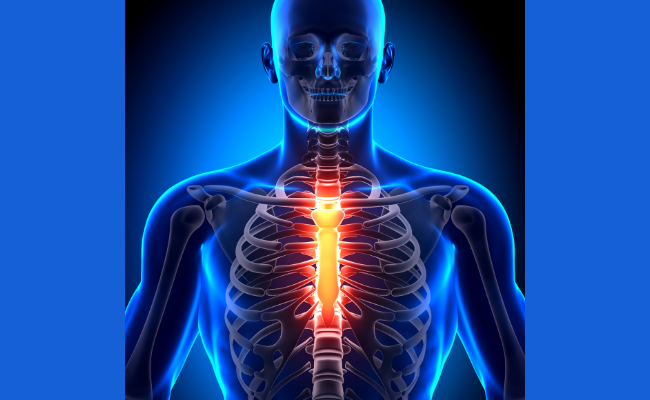How to Treat Tietze Syndrome?
- December 06, 2023
- No Comments

What is Tietze Syndrome?
Tietze Syndrome, named after German surgeon Alexander Tietze in 1921, is a rare inflammatory condition affecting joints where upper ribs attach to the sternum, known as the costosternal junction. It is characterized by swelling, tenderness, and chest pain, often resembling symptoms of a heart attack due to its proximity to the chest. Considered a variant of costochondritis, Tietze Syndrome is distinguished by the presence of swelling at the costosternal, costovertebral, or costochondral joints.
This inflammatory disorder arises when the cartilage in the costochondral joint, connecting the ribs to the breastbone, becomes irritated, leading to chest pain and swelling. Management typically involves a combination of rest and over-the-counter medications like nonsteroidal anti-inflammatory drugs (NSAIDs) to alleviate pain and reduce inflammation. With adequate rest, symptoms often show improvement within a few weeks, offering relief from this rare and discomforting condition.
Why Does Tietze Syndrome Occur?
- The exact cause of Tietze Syndrome remains unclear, making it a challenging condition to understand fully. However, it is believed to involve inflammation of the cartilage in the affected joints. Trauma, repetitive strain, or infections are considered potential triggers that may prompt an immune response, leading to inflammation in these joints. Autoimmune disorders, where the immune system mistakenly attacks healthy tissues, are also under consideration as contributing factors to the development of Tietze Syndrome. Genetic predisposition may play a role in some cases, making certain individuals more susceptible to this inflammatory condition.
- The inflammatory process in Tietze Syndrome primarily affects the cartilage, leading to localized pain, tenderness, and swelling. The symptoms can be aggravated by movement or pressure on the affected area, such as when coughing or sneezing. Additionally, the proximity of the affected joints to the chest can cause anxiety, as the symptoms may be mistaken for those of more serious conditions like a heart attack.
How is Tietze Syndrome Diagnosed?
- Diagnosing Tietze Syndrome can be challenging due to its symptoms often resembling those of more serious conditions, such as heart disease. Healthcare professionals typically start with a thorough medical history and physical examination. The hallmark sign is tenderness and swelling at the costosternal, costovertebral, or costochondral joints. To rule out other possible causes, imaging studies like X-rays, CT scans, or MRI may be conducted. Blood tests may also be ordered to check for inflammation markers.
- Given the rarity of Tietze Syndrome, misdiagnosis is not uncommon. Therefore, a comprehensive evaluation that includes ruling out other potential causes of chest pain is essential for an accurate diagnosis.
Treatment Solutions for Tietze Syndrome:
- Pain Management: Nonsteroidal anti-inflammatory drugs (NSAIDs) are commonly recommended to alleviate pain and reduce inflammation associated with Tietze Syndrome. Medications like ibuprofen or naproxen can be effective in managing mild to moderate symptoms. However, it's important to use these medications under the guidance of a healthcare professional, considering potential side effects and contraindications.
- Rest and Avoidance of Aggravating Factors: Rest is crucial for allowing the inflamed joints to heal. Activities that may exacerbate symptoms, such as heavy lifting or strenuous exercise, should be avoided during flare-ups. Resting the affected area helps reduce inflammation and prevents further irritation, promoting a faster recovery.
- Heat or Cold Therapy: Applying heat or cold to the affected area can provide relief. Heat helps to increase blood flow and relax muscles, while cold therapy can reduce inflammation and numb the area. Patients may experiment with both methods to determine which works best for them. It's important to use heat or cold therapy judiciously and avoid prolonged exposure to extreme temperatures.
- Physical Therapy: Physical therapy plays a significant role in managing Tietze Syndrome. Therapists can design exercises to improve posture, strengthen surrounding muscles, and increase mobility in the affected joints. Stretching exercises may also be incorporated to enhance flexibility. A personalized physical therapy plan helps address the specific needs of each individual, contributing to long-term symptom management.
- Local Injections: In some cases, healthcare providers may recommend corticosteroid injections directly into the inflamed joints to provide quick and targeted relief from pain and inflammation. These injections should be administered by a qualified medical professional and are usually considered when other conservative measures have not provided sufficient relief.
Benefits of Treating Tietze Syndrome:
- Pain Relief: Effective treatment can significantly reduce pain and discomfort associated with Tietze Syndrome, improving the overall quality of life for individuals affected by the condition. By addressing inflammation, pain medications, and other therapeutic interventions, patients can experience relief and a return to normal daily activities.
- Improved Functionality: Physical therapy and targeted exercises can enhance joint mobility and strengthen surrounding muscles, contributing to improved functionality and a return to normal daily activities. By addressing the underlying causes of Tietze Syndrome, individuals can regain their range of motion and reduce the impact of symptoms on their daily lives.
- Prevention of Complications: Timely and appropriate treatment can help prevent potential complications associated with Tietze Syndrome, such as chronic pain, muscle weakness, or limitations in range of motion. By addressing the condition early on, healthcare professionals can work with patients to develop a comprehensive management plan that minimizes the risk of long-term complications.
- Enhanced Well-being: Managing symptoms and addressing the underlying inflammation can positively impact the mental and emotional well-being of individuals with Tietze Syndrome. Reduced pain and improved mobility contribute to an overall sense of well-being, helping patients cope with the challenges posed by this inflammatory disorder.
- Avoidance of Unnecessary Medical Interventions: Accurate diagnosis and proper management of Tietze Syndrome can help avoid unnecessary medical interventions or surgeries that may be considered if the condition is misdiagnosed as a more serious cardiovascular issue. By providing targeted and appropriate care, healthcare professionals can guide patients toward effective treatments without resorting to invasive procedures that may not be warranted.
Comments (0)